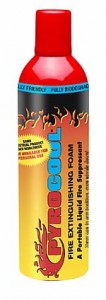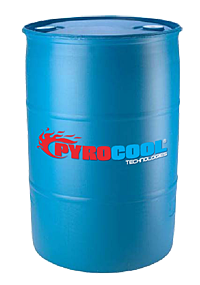The Presidential Green Chemistry Challenge Award
was instituted to recognize and promote innovative chemical technologies that prevent pollution and have broad applicability in industry. The Presidential Green Chemistry Challenge Award is sponsored by the Office of Chemical Safety and Pollution Prevention of the United States Environmental Protection Agency (EPA) in partnership with the American Chemical Society Green Chemistry Institute and other members of the chemical community.

Pyrocool Aerosol
Carol Browner, EPA Administrator in 1998, described Pyrocool Technologies as “one of the leaders of environmental innovation in this country.” She also described Pyrocool FEF as “the technology for the third millennium: the development and commercial introduction of an environmentally responsible fire extinguishment and cooling agent”.
Pyrocool FEF (fire extinguishing foam) is an industrial fire extinguishing chemical that is effective on Class A, Class B, Class D and pressurized/3 dimensional fires. It is used at a maximum mixing ratio of 0.4% (4 gallons per 1,000 gallons). When kept in its original container, Pyrocool FEF has a minimum 10 year shelf life.
Following the use of Pyrocool FEF, there will be no special clean up regimen to follow.
Following the use of AFFF significant time and resources will be required to properly clean up and remediate the area of any AFFF application (accidental discharge or fire application).
Pyrocool is a patented cooling agent. Pyrocool has been used primarily as a fire extinguishing agent because it rapidly attacks the heat side of the fire triangle. The composition of Pyrocool allows for large quantities of water to adhere to the surfaces that are to be cooled. Cooling is quickly achieved by spraying Pyrocool on the heated object.
There are a number of independent tests conducted by SGS. The most dramatic demonstrated the cooling of Pyrocool with a magnesium fire. The starting temperature was 1,700 degrees C (this was as high as the thermal imaging device reads – temperature was probably about 2,000 degrees C). Pyrocool reduced the temperature to 33 degrees C in 30 seconds.
Pyrocool FEF extinguishes fires 70% to 90% faster than water, or water mixed with conventional chemicals. The “NASSIA” fire, summarized below is a good example – Lloyds predicted it would take 10 days to extinguish the fire. The fire was extinguished by SmitTak in 12 ½ minutes using less than 9 X 55 gallon drums of Pyrocool.
Some examples of real world application of Pyrocool FEF, in addition to being used in certain areas of Ground Zero following the 9/11 attack are:

Pyrocool FEF in a drum
98,000 ton oil tanker fire (NASSIA). Lloyds of London stated it would take at least 10 days to extinguish using conventional foam (AFFF). SmitTak, the world’s largest marine salvage company was contracted to fight this fire. Pyrocool FEF was used and the fire was extinguished in 12 ½ minutes using less than 9 – 55 gallon drums of Pyrocool FEF.
20,000 gallon pressurized acetone rail car fire (pressurized polar solvent fire). 20,000 gallons of water mixed with 600 gallons of conventional foam (AFFF) was used with no success. 10 gallons of Pyrocool FEF mixed with 2,500 gallons of water and applied with a hand line extinguished the fire. A further 20 gallons of Pyrocool FEF was applied to the saddle tanks of the engine to cool the diesel fuel that could be heard boiling in the saddle tanks. The local fire chief stated “the use of Pyrocool saved us a lot of time and also had the benefit of allowing the scene to be cleaned up and the railroad back running quickly”. (NFPA listed this fire as one of the top 50 fires of 1998)
Fluorinated surfactants (fluorosurfactants) are a key ingredient in aqueous film-forming foams (AFFF). Around 2000 it was determined that AFFF made from an 8 or more carbon chain was persistent, bioaccumulating and toxic.
Under the US EPA global stewardship program the 8 or more carbon chain fluorinated surfactants will be reduced by 95% (over 2000 year levels) by 2010 with a goal of total elimination by 2015.
In 2000, 3M had environmental concerns about the fluorinated surfactant in its product and decided to withdraw from the AFFF market. Even though no other manufacturers used the same method as 3M to produce its 8 or more carbon chain fluorosurfactants, the withdrawal of 3M from AFFF production raised a red flag.
